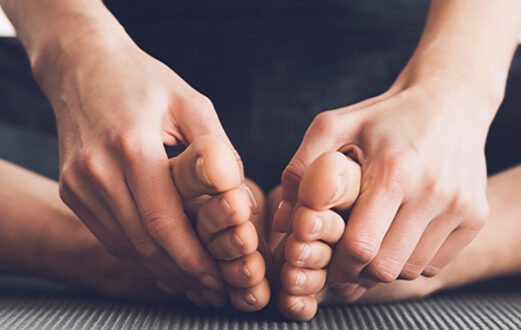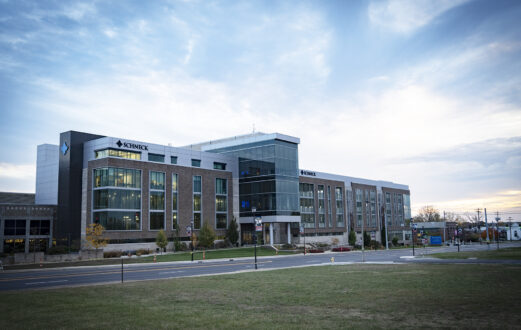Common Foot Issues

Athlete's Foot
Also known as Tinea Pedia, athlete’s foot affects 3-15% of the population in the United States with men being more susceptible1. Athlete’s foot is a fungus that causes the skin between your toes to redden and crack. The fungus is often found in wet public areas such as pools, showers, and locker rooms. The moisture and warmth in shoes can allow athlete’s foot to grow faster2.
Symptoms of Athlete’s Foot
Athlete's foot may be identified by the following symptoms:
- Dry, scaly skin between the toes
- Inflammation of the skin
- Persistent itching of the skin on your feet
Symptoms may present most frequently between the toes but can often spread to the bottom of your feet if left untreated. It is important to note that the fungus may spread to other parts of the body through contact with the infected foot.
Treating & Preventing Athlete’s Foot
Several over-the-counter topical anti-fungal creams found at your local pharmacy have proven effective in treating Athlete’s Foot. If the initial treatment proves to be ineffective, your podiatrist may prescribe a more effective anti-fungal medication or an antibiotic.
Feet should be cleaned frequently to prevent further growth of the fungus. Talcum powder should be used in shoes to reduce moisture and create a dryer environment. If possible, consider switching to lighter, thinner shoes that promote better air circulation.
Ingrown Toenails
Ingrown toenails are the most common nail impairment, affecting 20 out of 100 people on average3. They are caused when the outer sides of a toenail grow at an angle into the soft tissue of the toe instead of straight down4. Teenagers and young adults experience them most frequently due to hormonal changes and the amount of sweat their feet produce during higher amounts of physical activity. Tight shoes that place excess pressure on the front and sides of your toes are also a common cause of ingrown toenails.
Symptoms of Ingrown Toenails
Symptoms of ingrown toenails include swelling, drainage, redness, and odor. Ingrown toenails typically develop over three stages5.
- Stage 1: The side of the nail begins to grow into the soft tissue of the toe.
- Stage 2: The soft tissue area becomes inflamed and fills with white/yellow pus.
- Stage 3: The inflammation worsens and becomes visible. Pus continues to fill and ooze out of the affected soft tissue area.
Treating & Preventing Ingrown Toenails
Ingrown toenails can be treated at home if not severe. Clean the affected area, soak your foot in salt water for 10-15 minutes, then dry and bandage the area after applying a topical antiseptic. Aggressive forms of nail removal should be avoided and left to a podiatrist. Individuals with diabetes or circulatory disorders should avoid self-treatment of ingrown toenails and instead visit their podiatrist.
Wearing looser shoes and exercising caution when trimming your toenails can help prevent ingrown toenails in the future. More permanent treatments are available if ingrown toenails become chronic.
Corns & Calluses
Corns, typically found on the top of the foot, and calluses, typically found on the bottom of a foot, are areas of thickened skin developed by repeated friction. Calluses are flatter while corns are thicker and deeper. While not usually serious, a corn or callus can lead to more severe issues in individuals with diabetes or poor circulation.
Corns and calluses are usually caused by excessive rubbing with the side or interior of a shoe. If your foot experiences certain deformities such as hammer toes, you may be more prone to corns or calluses.6
Symptoms of Corns & Calluses
Corns and calluses are rough formations on the bottom of your foot or the tops of your toes. They are rounded bumps of thick skin that may or may not be uncomfortable.
Treating & Preventing Corns & Calluses
If your corn or callus is not causing you discomfort, it is best to leave it alone and instead focus on addressing the possible cause of the problem such as footwear. Painful corns or calluses may be removed, often without pain, by a podiatrist using a sharp blade. Self-removal of a corn or callus is never recommended and can lead to serious injury.
Consider using gel inserts to relieve friction points in the bottom of your feet in order to prevent calluses. Properly fitting shoes can reduce the occurrence of corns.
Sprains, Strains & Fractures
Foot and ankle fractures are breaks in the bones found in those areas. An ankle or foot sprain is a less serious injury to the soft tissue. Injuries during physical activity tend to be the most common causes of sprains and fractures. Athletes engaging in sports that require them to jump or run tend to experience a sprain or fracture most often.
Symptoms of Sprains, Strains, & Fractures
Depending on the severity of the injury, sprains, and fractures can carry different symptoms. A sprain may cause swelling, bruising, and pain in the injured area. A small fracture may exhibit similar symptoms but be less obvious to the naked eye.
Treating & Preventing Sprains, Strains, & Fractures
Minor sprains and strains can be treated at home using the RICE acronym: Rest, Ice, Compression, Elevation. It’s important to minimize the amount of time spent using the sprained foot or ankle in order to allow the healing process to be most effective.
Due to the possible range of their severity, fractures can be treated in a number of ways. If you experience severe pain after an injury or notice any abnormalities in the structure of your foot, consider visiting a podiatrist for a thorough evaluation.
Prevent sprains and fractures by giving your body ample time to warm up before engaging in high amounts of physical activity.7
Let's Get You Back On Your Feet
Looking for a foot specialist? Schneck’s podiatry and orthopedic providers are top-notch. Schedule an appointment today and get back the mobility you’ve been missing.



